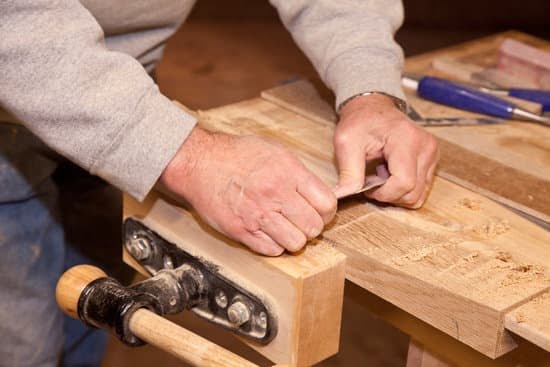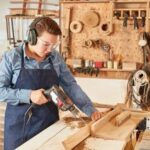Woodworking is a timeless and rewarding hobby that allows individuals to create beautiful, functional pieces out of wood. Whether you are just starting or looking to expand your woodworking skills, having the right equipment is essential for success. In this article, we will explore the fundamental equipment needed for woodworking projects, from safety gear to hand tools, power tools, workbench setup, measurement and marking tools, finishing and sanding tools, as well as additional specialized equipment for advanced techniques.
To embark on any woodworking project, it’s crucial to understand what equipment is needed for woodworking. This includes acquiring the necessary safety gear to protect yourself from potential hazards in the workshop. In addition to safety equipment, having a comprehensive collection of hand tools is essential for shaping and crafting wood with precision and accuracy. Moreover, power tools play a significant role in expediting the woodworking process and can help achieve professional results.
Creating a conducive workspace with a sturdy workbench and an assortment of clamps is imperative for stability and practicality. Precision is also key in woodworking; thus, investing in high-quality measurement and marking tools is crucial for accurate cutting and shaping. Furthermore, achieving a professional finish on your woodworking projects requires specialized finishing and sanding tools. Lastly, more advanced techniques may require additional specialized equipment to further enhance your woodworking skills.
Safety First
Woodworking can be an incredibly rewarding and fulfilling hobby or profession, but it also comes with its fair share of risks. Safety should always be the top priority when embarking on any woodworking project. This section will outline the essential safety equipment needed to ensure a safe and enjoyable woodworking experience.
Protective Gear
One of the most important aspects of woodworking safety is wearing the appropriate protective gear. This includes eye protection such as safety goggles to shield your eyes from flying wood chips and debris, as well as hearing protection, especially when operating loud power tools. Additionally, wearing a dust mask is crucial to protect your lungs from inhaling potentially harmful wood particles and sawdust.
First Aid Kit
Accidents can happen in any workshop setting, so it’s critical to have a well-stocked first aid kit readily available. Your first aid kit should include essentials such as bandages, antiseptic ointment, sterile gauze pads, adhesive tape, and scissors. Having a first aid kit on hand ensures that you can quickly address any minor injuries that may occur during woodworking projects.
Fire Safety Equipment
Woodworking involves working with materials that are highly flammable, so it’s imperative to have fire safety equipment in place. This may include a fire extinguisher rated for wood fires, a smoke detector in your workspace, and an emergency exit plan in case of fire or other emergencies.
By prioritizing safety and having the necessary equipment in place, woodworkers can minimize the risks associated with their craft and focus on creating beautiful and functional pieces with confidence.
Hand Tools
Woodworking requires a variety of hand tools to complete different tasks, from shaping and carving to assembling and finishing. Whether you’re a beginner or a seasoned woodworker, having the right hand tools is essential for any woodworking project. Here is a comprehensive list of hand tools needed for woodworking:
1. Chisels: Used for carving, cutting, and shaping wood, chisels come in various sizes and shapes to suit different woodworking needs.
2. Hand Saw: A good quality hand saw is necessary for cutting wood into smaller pieces or making precision cuts that cannot be achieved with power saws.
3. Clamps: Essential for holding pieces of wood together firmly while the glue dries or when making intricate cuts.
4. Mallet: Used in conjunction with chisels to apply force without damaging them, a wooden mallet is ideal for woodworking projects.
5. Block Plane: Perfect for smoothing rough surfaces, trimming end grain, and removing thin layers of wood.
When setting up your workshop or starting a new woodworking project, it’s important to have these essential hand tools on hand to ensure the success of your endeavors.
Whether you’re working on small DIY projects or larger-scale woodworking creations, having the right hand tools will make the process more efficient and enjoyable. From chisels and hand saws to clamps and mallets, these tools are indispensable for any woodworking enthusiast.
Power Tools
When it comes to woodworking, power tools can significantly increase productivity and efficiency. Here is a list of essential power tools every woodworker should have in their arsenal:
1. Circular Saw: Ideal for making straight cuts, a circular saw is a versatile tool that can handle various materials and bevel cuts.
2. Table Saw: One of the most important power tools for woodworking, a table saw is perfect for making precise rip cuts and crosscuts. It’s crucial for cutting large pieces of wood accurately.
3. Power Drill: A power drill is essential for driving screws, creating holes, and countersinking screws in woodworking projects. Consider getting both corded and cordless drills for maximum flexibility.
4. Jigsaw: For cutting curves or irregular shapes in wood, a jigsaw is indispensable. It can also be used to make plunge cuts and cut holes in the middle of a board.
5. Router: A versatile tool that can be used for shaping edges, hollowing out grooves, and creating intricate designs in wood. Routers come in both hand-held and table-mounted versions.
6. Random Orbital Sander: Achieve smooth finishes on your woodworking projects with a random orbital sander. Its random sanding pattern minimizes swirl marks, making it perfect for final finishing touches.
These power tools are just the tip of the iceberg when it comes to equipping your workshop for woodworking projects. Investing in quality power tools will not only make your work easier but also yield professional results.
Workbench and Clamps
A proper workbench and clamps are essential for setting up a workspace for woodworking. A sturdy and well-built workbench provides a stable and level surface for all woodworking projects. The workbench should be at a comfortable working height, allowing woodworkers to carry out their tasks without straining their back or arms. Additionally, having a spacious workbench allows for ample space to maneuver large pieces of lumber and other materials.
Clamps are necessary for securing wood in place while cutting, shaping, or joining pieces together. There are different types of clamps, including bar clamps, pipe clamps, and spring clamps, each serving a specific purpose in woodworking projects. Having a variety of clamps on hand ensures that woodworkers can secure materials of different shapes and sizes as needed.
In addition to the workbench and clamps, it is also important to have a dedicated area in the workshop for storing tools and materials. This organization helps in maintaining a clean and efficient workspace where woodworkers can easily access the equipment they need. Proper lighting is also crucial when setting up a woodworking area to ensure precision and accuracy in all tasks.
| Woodworking Equipment | Importance |
|---|---|
| Workbench | Provides stable surface for projects |
| Clamps | Secures wood during tasks |
| Tool Storage | Maintains organization and efficiency |
Measurement and Marking Tools
When it comes to woodworking, precision is key in achieving professional-looking results. This is why having the right measurement and marking tools is essential for any woodworking project. Whether you are a novice or an experienced woodworker, having the proper equipment for accurate measurements and precise markings will make a significant difference in the outcome of your projects.
Tape Measure and Ruler
One of the most basic but crucial measurement tools for woodworking is a reliable tape measure or ruler. This tool is used to accurately measure the dimensions of wood pieces, ensuring that they are cut to the correct length and width based on your project’s specifications.
Square
A combination square or speed square is another essential tool for woodworking. It is used to mark straight and 90-degree angles on wood, allowing for precise cuts and joints. Ensuring that your wood pieces are perfectly squared off can greatly impact the overall quality and stability of your finished project.
Marking Knife and Pencil
For accurate markings on wood, a marking knife or fine pencil is indispensable. These tools allow you to make clear and precise lines on the wood surface, indicating where cuts, joints, or holes need to be made. This level of precision can make a significant difference in how well your pieces fit together in the final assembly.
Finishing and Sanding Tools
Achieving a professional finish is a crucial step in any woodworking project, and having the right tools can make all the difference. Sanding tools are essential for smoothing out rough edges, removing old finishes, and preparing the wood surface for staining or painting.
One of the most basic tools you will need is a sandpaper, which comes in different grits for varying levels of smoothness. A sanding block or sanding sponge can also be used to provide leverage and control while sanding.
In addition to sandpaper, a power sander can save time and effort when working on larger projects. There are different types of power sanders available, including orbital sanders, belt sanders, and random orbital sanders. Each type serves a specific purpose and provides varying levels of aggressiveness in terms of material removal.
Once the wood has been properly sanded, finishing tools such as brushes, sprayers, or applicators are needed to apply stains, paints, varnishes, or other finishes. These tools play a significant role in determining the final look and quality of your woodworking project. With the right finishing tools and techniques, you can achieve a professional finish that will make your woodworking projects stand out.
| Woodworking Tool | Description |
|---|---|
| Sandpaper | Comes in different grits for varying levels of smoothness |
| Power Sander | Orbital sanders, belt sanders, random orbital sanders |
| Finishing Tools | Brushes, sprayers, applicators for applying stains, paints, varnishes |
Additional Equipment
When it comes to advanced woodworking techniques and projects, having specialized equipment can make a world of difference in the quality and craftsmanship of the end result. While basic hand tools and power tools are essential for most woodworking projects, there are some additional pieces of equipment that can take your work to the next level.
One important piece of specialized equipment for advanced woodworking is a router table. This tool allows woodworkers to create intricate designs and shapes by using a spinning bit to carve into the wood. With a router table, you can achieve precise cuts and create beautiful edges or patterns on your woodworking projects.
Another valuable piece of equipment for advanced woodworking is a bandsaw. This versatile tool allows for intricate curved cuts and resawing large pieces of lumber into thinner boards. For more complex designs and detailed work, a bandsaw can be an invaluable addition to any woodworking shop.
In addition to the router table and bandsaw, other specialized equipment for advanced woodworking includes a lathe for turning wood, a jointer for creating flat surfaces on rough lumber, and a planer for achieving consistent thickness throughout the wood. These tools may not be necessary for every project, but they can greatly expand the capabilities of a woodworker looking to take on more complex or detailed work.
Conclusion
In conclusion, woodworking requires a range of equipment to ensure both safety and precision in the creation of projects. From basic hand tools like chisels and saws to power tools such as drills and sanders, having the right equipment is crucial for success in woodworking. In addition to the tools themselves, having a well-equipped workbench with clamps, as well as measurement and marking tools, is essential for ensuring accuracy and efficiency in woodworking projects.
Furthermore, it is important to prioritize safety when working with wood. The use of safety equipment such as goggles, ear protection, and dust masks cannot be overstated. These items are crucial for protecting your eyes, ears, and respiratory system from potential hazards while working with wood.
As woodworking skills progress, there may be a need for specialized finishing and sanding tools to achieve a professional look on projects. Additionally, advanced techniques may require additional equipment specific to certain woodworking tasks. However, by starting with the essential equipment outlined in this article, individuals can build a strong foundation for their woodworking endeavors. Overall, understanding what equipment is needed for woodworking is crucial for anyone looking to take on woodworking projects with confidence and success.
Frequently Asked Questions
What Kind of Tools Do I Need for Woodworking?
In woodworking, you will need a variety of hand tools and power tools. Hand tools may include hammers, chisels, hand saws, and measuring tools such as rulers and squares. Power tools often used in woodworking include a table saw, miter saw, drill press, power sander, and router.
What Is Needed for a Woodworking Shop?
A woodworking shop will require a combination of equipment and supplies to support the woodworking process. This may include workbenches, clamps, storage for wood materials, protective gear such as goggles and masks, as well as finishing supplies like sandpaper, wood glue, and varnish.
What Machines Do You Need in a Wood Workshop?
Different machines serve different purposes in a wood workshop. Some essential machines include a table saw for straight cuts in wood, a band saw for curved or irregular cuts, a jointer for creating flat surfaces on the edges of boards, a planer for creating uniform thickness throughout boards, and a router for shaping and creating joinery in wood pieces.
These machines are fundamental to the woodworking process but can vary based on the specific projects being undertaken.

Hi everyone! I’m a woodworker and blogger, and this is my woodworking blog. In my blog, I share tips and tricks for woodworkers of all skill levels, as well as project ideas that you can try yourself.





